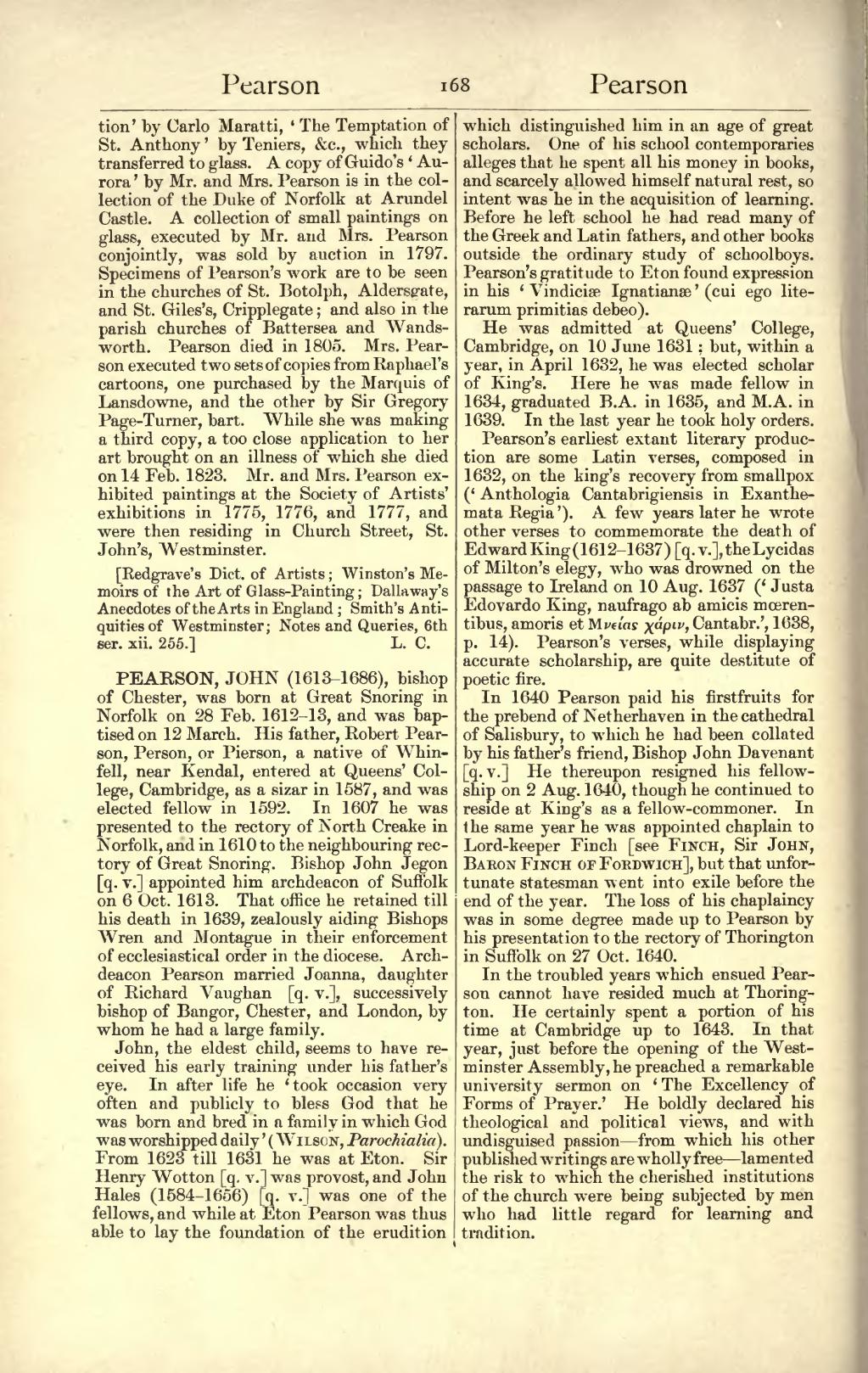tion’ by Carlo Maratti, ‘The Temptation of St. Anthony’ by Teniers, &c., which they transferred to glass. A copy of Guido's ‘Aurora’ by Mr. and Mrs. Pearson is in the collection of the Duke of Norfolk at Arundel Castle. A collection of small paintings on glass, executed by Mr. and Mrs. Pearson conjointly, was sold by auction in 1797. Specimens of Pearson's work are to be seen in the churches of St. Botolph, Aldersgate, and St. Giles's, Cripplegate; and also in the parish churches of Battersea and Wandsworth. Pearson died in 1805. Mrs. Pearson executed two sets of copies from Raphael's cartoons, one purchased by the Marquis of Lansdowne, and the other by Sir Gregory Page-Turner, bart. While she was making a third copy, a too close application to her art brought on an illness of which she died on 14 Feb. 1823. Mr. and Mrs. Pearson exhibited paintings at the Society of Artists' exhibitions in 1775, 1776, and 1777, and were then residing in Church Street, St. John's, Westminster.
[Redgrave's Dict. of Artists; Winston's Memoirs of the Art of Glass-Painting; Dallaway's Anecdotes of the Arts in England; Smith's Antiquities of Westminster; Notes and Queries, 6th ser. xii. 255.]
PEARSON, JOHN (1613–1686), bishop of Chester, was born at Great Snoring in Norfolk on 28 Feb. 1612–13, and was baptised on 12 March. His father, Robert Pearson, Person, or Pierson, a native of Whinfell, near Kendal, entered at Queens' College, Cambridge, as a sizar in 1587, and was elected fellow in 1592. In 1607 he was presented to the rectory of North Creake in Norfolk, and in 1610 to the neighbouring rectory of Great Snoring. Bishop John Jegon [q. v.] appointed him archdeacon of Suffolk on 6 Oct. 1613. That office he retained till his death in 1639, zealously aiding Bishops Wren and Montague in their enforcement of ecclesiastical order in the diocese. Archdeacon Pearson married Joanna, daughter of Richard Vaughan [q. v.], successively bishop of Bangor, Chester, and London, by whom he had a large family.
John, the eldest child, seems to have received his early training under his father's eye. In after life he ‘took occasion very often and publicly to bless God that he was born and bred in a family in which God was worshipped daily’ (Wilson, Parochialia). From 1623 till 1631 he was at Eton. Sir Henry Wotton [q. v.] was provost, and John Hales (1584–1656) [q. v.] was one of the fellows, and while at Eton Pearson was thus able to lay the foundation of the erudition which distinguished him in an age of great scholars. One of his school contemporaries alleges that he spent all his money in books, and scarcely allowed himself natural rest, so intent was he in the acquisition of learning. Before he left school he had read many of the Greek and Latin fathers, and other books outside the ordinary study of schoolboys. Pearson's gratitude to Eton found expression in his ‘Vindiciæ Ignatianæ’ (cui ego literarum primitias debeo).
He was admitted at Queens' College, Cambridge, on 10 June 1631; but, within a year, in April 1632, he was elected scholar of King's. Here he was made fellow in 1634, graduated B.A. in 1635, and M.A. in 1639. In the last year he took holy orders.
Pearson's earliest extant literary production are some Latin verses, composed in 1632, on the king's recovery from smallpox (‘Anthologia Cantabrigiensis in Exanthemata Regia’). A few years later he wrote other verses to commemorate the death of Edward King (1612–1637) [q. v.], the Lycidas of Milton's elegy, who was drowned on the passage to Ireland on 10 Aug. 1637 (‘Justa Edovardo King, naufrago ab amicis mœrentibus, amoris et Mneias Charin, Cantabr.’, 1638, p. 14). Pearson's verses, while displaying accurate scholarship, are quite destitute of poetic fire.
In 1640 Pearson paid his firstfruits for the prebend of Netherhaven in the cathedral of Salisbury, to which he had been collated by his father's friend, Bishop John Davenant [q. v.] He thereupon resigned his fellowship on 2 Aug. 1640, though he continued to reside at King's as a fellow-commoner. In the same year he was appointed chaplain to Lord-keeper Finch [see Finch, Sir John, Baron Finch of Fordwich], but that unfortunate statesman went into exile before the end of the year. The loss of his chaplaincy was in some degree made up to Pearson by his presentation to the rectory of Thorington in Suffolk on 27 Oct. 1640.
In the troubled years which ensued Pearson cannot have resided much at Thorington. He certainly spent a portion of his time at Cambridge up to 1643. In that year, just before the opening of the Westminster Assembly, he preached a remarkable university sermon on ‘The Excellency of Forms of Prayer.’ He boldly declared his theological and political views, and with undisguised passion—from which his other published writings are wholly free—lamented the risk to which the cherished institutions of the church were being subjected by men who had little regard for learning and tradition.
